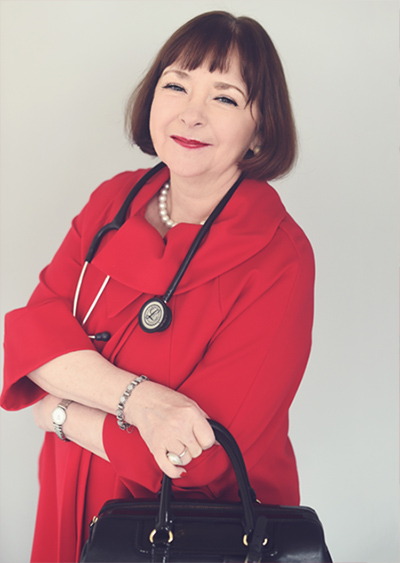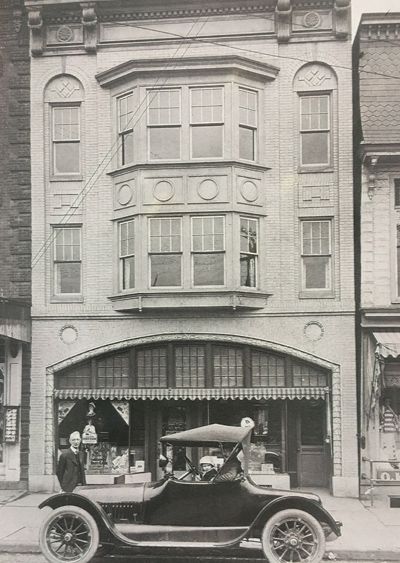
Mary Simmonds, MD, MCP ’75 Source: Bevore Contemporary Portraits
Setting Out
Medicine runs generations back in the Simmonds family. Mary’s great-grandparents were pharmacists and founded the Simmonds Pharmacy in Shamokin, Pennsylvania, the same town where her grandfather would practice medicine as a general practitioner. Her father, Henry T. Simmonds Jr., was a radiologist; he and his wife, Harriet Lynn, who was a medical technologist, settled in the Harrisburg area.
Simmonds vividly recalls the precise moment when she knew she would go into medicine. When she was around the age of 12, a school assignment asked her to choose someone to interview about their job, and she chose her father. As she observed him that day, she came to admire his intricate knowledge of medicine. She was impressed that he had “the privilege of that information.” By the time Simmonds went off to Smith College, from which she would graduate in 1971, she knew medicine was the path for her. “At that time, nationwide, the percentage of women in medical school was 10% — which I’ve often pointed out was better than 2%. I have personally known women physicians who are older than me and were one of very few women in their medical school class. I really take my hat off to those women. They started paving the way, and I suppose I have continued to pave the way.”
In the fall of 1971, Simmonds entered Medical College of Pennsylvania, which had the uncommon trait of being majority women, having just become coed and changed its name from Woman’s Medical College. “I was so excited!” Simmonds says. “That was the key to the rest of my life, to just have a place in medical school. I remember that I didn’t sleep a wink for three nights, just going over and over my notes.”
Following Footsteps and Paving the Way
After graduating from MCP in 1975, Simmonds did her residency in internal medicine at the Geisinger Medical Center in Danville, Pennsylvania. “It was not uncommon for me to be the only woman in the group on rounds,” she recalls.
In addition to the exposure to medicine through her parents, she had been introduced at a young age to Herbert S. Bowman, MD, who was raised in Harrisburg. After his training in hematology he had returned to the area and “was not only a clinician, but also a teacher, a clinical researcher and a wonderful role model,” according to Simmonds. Shadowing Bowman was part of what helped her discover that hematology might be the path for her. After completing her residency in 1978, she went back to Philadelphia for a two-year fellowship in hematology at Thomas Jefferson University, where Bowman had also trained.

Three generations of the Simmonds family in front of the Simmonds Pharmacy in Shamokin, Pennsylvania. Mary’s great-grandfather stands out front, and her father sits in her grandfather’s lap in the car. Photo courtesy of Mary Simmonds, MD.
Serving the Community
In 1980, Simmonds and her husband, attorney Richard Stewart, came back to central Pennsylvania and settled in her childhood home in New Cumberland. She completed a third year of fellowship in medical oncology at the Hershey Medical Center and then joined the faculty of Penn State College of Medicine. The Pennsylvania division of the American Cancer Society (ACS) is across the street from the Hershey Medical Center. Simmonds recounts, “One day in 1981, one of my colleagues and I decided to go over there and find out more about the ACS. The next thing I knew, I was asked to be on a committee, and then I become chair of that committee. In 1988, I became the second woman president of the Pennsylvania division of the ACS.” Her leadership only grew from there. “Not too long after that I was asked to be on a national committee, and then to chair that committee. In 2003, I became the first woman president of the national American Cancer Society,” Simmonds says, noting that her time serving the ACS was “a privilege.”
When Simmonds finished her postgraduate training, oncology was just an emerging field. “The average person, even other doctors, thought, ‘How could you be an oncologist?’” Simmonds says. Earlier in the 20th century, she explains, “people didn’t even want to talk about the word ‘cancer.’ One of the reasons that there were few oncologists was that if anybody really sought out treatment, they went to the big city. There weren’t oncologists all around like there are today. It has been a privilege to live through all the progress that has been made in this field.”
Simmonds credits the American Cancer Society with helping to change that scene. As the Society developed, she says, it founded branches all over. “There was a presence in every community, every county, every state.” Higher cancer survival rates are one obvious outcome of this progress. In addition, the symptoms of cancer are being treated more effectively, particularly pain.
Early in her career, Simmonds says, pain as a symptom in cancer patients wasn’t being well addressed, partly due to “lack of knowledge on the part of physicians, and ideas in society that morphine was dangerous.” Simmonds had the opportunity to become involved in clinical research as she transitioned into practicing in the Harrisburg community. In 1990, she worked on clinical trials with transdermal fentanyl, which was later marketed as Duragesic. “It was gratifying to be able to teach other health care professionals how to use this medication effectively.”
Home and All That Comes With It
None of Simmonds’ firsts should be surprising given that she was also the first female physician in her hometown of New Cumberland. But in addition to breaking new ground in medicine, the years have presented Simmonds with plenty of opportunities to be involved in her hometown community, in church and local arts and theatre groups. “This is my community, the Harrisburg community,” Simmonds says. “It’s been good to me, and giving back to it has been a good thing. My mother did volunteer work of her own, and she was a role model for me. My parents also modeled philanthropy.”
Her own philanthropy extends beyond her hometown. With Drexel, Simmonds established the Mary A. Simmonds Endowed Scholarship Fund for female medical students. “This scholarship is a wonderful opportunity to serve my alma mater, and I wish all alumni knew more about how to give back in this way. I think that Drexel has done a very good job in honoring the history and traditions of Woman’s Medical College, Medical College of Pennsylvania and Hahnemann University.”
Simmonds has now lived in the same house since she was 7. In the corner sits her grandfather’s desk, and medical memorabilia from previous generations of medical professionals are sprinkled around the residence. Her grandfather’s old doctor bag made a trip out of the house once more to join Simmonds on stage for her keynote speech at the 2012 Drexel University College of Medicine Scholarship Celebration at Queen Lane. In 2020, Simmonds was named a Distinguished Physician by the Society of Diplomates of Harrisburg. The plaque says, “Thank you for your commitment, dedication and service to our community.” She accepted it with her grandfather’s doctor bag in tow again.
“I have had a great career in medicine. It was rich with sharing patients’ challenges with serious illness, teaching others to be more knowledgeable and effective, and advancing the field through clinical research. As I look back now, there’s nothing else I would have wanted to do.”